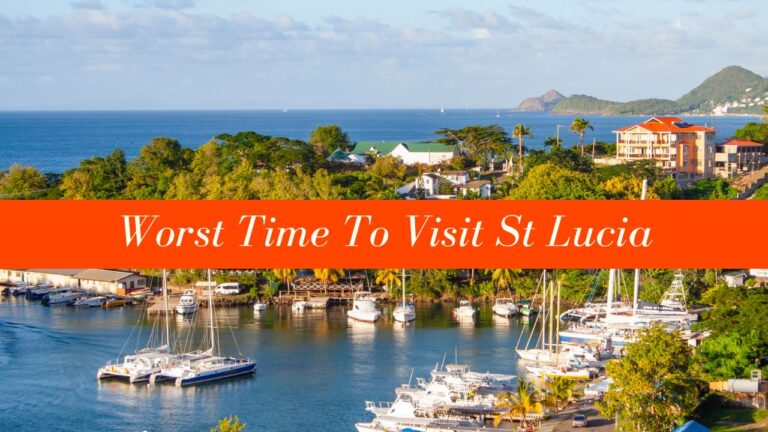Are you dreaming of exploring the enchanting Galapagos Islands? The pristine landscapes and unique wildlife of this archipelago are undoubtedly alluring, but like any other travel destination, timing is crucial for a memorable experience. In this guide, we’ll dive into the worst time to visit Galapagos, helping you plan your trip with confidence and insight.
Understanding Galapagos’ Climate: Dry and Wet Seasons
Galapagos experiences two main seasons: the dry season (June to December) and the wet season (January to May). Each season brings its own set of advantages and challenges, allowing you to tailor your visit based on your preferences.
- Dry Season (June to December):
- Advantages: During the dry season, you’ll encounter pleasant temperatures and calm seas. This is an excellent time for diving and snorkeling, as underwater visibility is at its best. Wildlife, including iconic species like giant tortoises and blue-footed boobies, is also more active.
- Challenges: While the dry season is generally considered the best time to visit Galapagos, it’s also the peak tourist season. The islands can get crowded, and prices for accommodations and tours tend to be higher.
- Wet Season (January to May):
- Advantages: The wet season offers lush landscapes and vibrant vegetation. It’s the nesting season for many species, including sea turtles and albatrosses, providing unique opportunities for wildlife enthusiasts.
- Challenges: The wet season is characterized by occasional heavy rains and warm temperatures. While you can still enjoy your trip, outdoor activities may be interrupted, and sea conditions can be rough.
The Worst Time to Visit Galapagos: The Shoulder Seasons
While both the dry and wet seasons have their merits, the shoulder seasons, which fall between these two main seasons, may not be the best choice for your Galapagos adventure.
- Early Dry Season (June): This month marks the transition from the wet season to the dry season. While the weather is improving, you might still encounter occasional showers.
- Early Wet Season (December): Similarly, December is the beginning of the wet season. While it brings lush landscapes, it’s not ideal for underwater activities due to reduced visibility.
Avoiding the Worst Time to Visit Galapagos: Alternatives and Planning Tips
If you’re flexible with your travel dates, you can avoid the peak tourist season and the challenges it brings. Consider visiting during the shoulder seasons or the late dry season (September to December) for a balanced experience.
Additionally, plan your trip well in advance to secure accommodations and tours at competitive prices. Galapagos has a limited number of visitors allowed at any given time, so booking ahead is crucial.
Also Read: Worst Time to visit french Polynesia
Why Is Rainy Season The Worst Time To Visit Galapagos?
The rainy season in the Galapagos Islands, which spans from January to April, is often considered the least favorable time to visit. There are several compelling reasons for this:
1. Cooler and Wetter Weather:
During the rainy season, the weather in the Galapagos becomes cooler and wetter. While it might still be enjoyable for some, the frequent rain can affect outdoor activities and sightseeing, making it less appealing for travelers seeking sunny adventures.
2. Muddy and Slippery Conditions:
The rain can turn the island’s roads and paths muddy and slippery, which can pose challenges for getting around safely. Hiking and exploring become more difficult and potentially hazardous due to these conditions.
3. Risk of Flooding:
The heavy rains increase the risk of flooding in certain areas of the islands, potentially causing damage to infrastructure and impacting travel plans. It’s essential to stay informed about local conditions and follow evacuation orders if necessary.
4. Higher Prices:
Because the rainy season is considered the least desirable time to visit, demand for accommodations and tours is typically lower. As a result, some hotels and tour operators may offer reduced prices. However, this doesn’t necessarily translate to a budget-friendly trip, as lower demand may also lead to fewer options and limited availability.
Precautions To Take When Visiting Galapagos During Rainy Season
If you’re determined to visit the Galapagos Islands during the rainy season, here are some precautions to help you make the most of your trip:
1. Bring Rain Gear:
Ensure you pack essential rain gear, including a raincoat, rain pants, and waterproof shoes. These items will keep you dry and comfortable when exploring the islands.
2. Be Prepared for Cooler Temperatures:
The average temperature during the rainy season is around 20 degrees Celsius (68 degrees Fahrenheit). Bring appropriate clothing to stay warm while enjoying your activities.
3. Check the Forecast:
Keep an eye on the weather forecast before you go. This will help you plan your daily activities around the weather, ensuring you make the most of any sunny intervals.
4. Don’t Let the Rain Stop You:
Rainy days in the Galapagos can still be enjoyable. There are plenty of indoor attractions, such as museums and visitor centers, where you can learn about the islands’ unique ecosystems and history. Plus, the rain often brings out the wildlife, providing fantastic opportunities for observation.
5. Be Aware of Flooding Risks:
Stay informed about local conditions and be aware of the potential for flooding. Follow any evacuation orders issued by authorities to ensure your safety.
While the rainy season in the Galapagos Islands may present challenges, with proper planning and the right mindset, you can still have a fantastic and rewarding trip, experiencing the islands’ incredible wildlife and stunning landscapes.

Alternative Destinations:
If the worst time to visit Galapagos aligns with your vacation dates, don’t worry. There are alternative destinations with similar natural beauty and wildlife experiences. Consider exploring the Ecuadorian Amazon, the Andes Mountains, or the historic city of Quito.
When not to go to Galapagos Islands?
The Galapagos Islands are best avoided during the rainy season, which runs from January to April. During this period, the islands experience frequent rain, cooler temperatures, and muddy conditions, which can impact outdoor activities and make travel less enjoyable.
What is the rainiest month in Galapagos?
The rainiest months in the Galapagos Islands are typically February and March. These months see the highest levels of rainfall, contributing to the wet conditions during the rainy season.
How many days recommended for Galapagos?
A recommended duration for a visit to the Galapagos Islands is around 7 to 10 days. This allows you to explore multiple islands, engage in various activities, and fully immerse yourself in the unique ecosystems and wildlife of the archipelago.
Is August a good time to go to Galapagos?
August is generally considered a good time to visit the Galapagos Islands. It falls within the dry season, offering pleasant weather, warmer temperatures, and excellent opportunities for wildlife observation, including the famous blue-footed boobies.
Is September good for Galapagos?
September is also a favorable time to visit the Galapagos Islands. It marks the transition from the dry season to the warmer season. Wildlife is active, and you can witness unique behaviors, such as the courtship rituals of marine iguanas.
What’s the best month to visit the Galapagos?
The best month to visit the Galapagos Islands depends on your preferences. Generally, May to June and September to November are considered the best times for a visit. During these periods, you can enjoy pleasant weather and witness various wildlife activities.
Is Galapagos nice in October?
October is a great time to visit the Galapagos Islands. The weather is warm and pleasant, and you can observe various wildlife species, including sea lions and Galapagos penguins.
Is October good for Galapagos?
Yes, October is a good time to visit the Galapagos Islands. The warmer weather and reduced rainfall make it an ideal time for outdoor activities and wildlife observation.
What is not allowed in Galapagos?
In the Galapagos Islands, several regulations are in place to protect the delicate ecosystems. Some activities that are not allowed include:
- Picking up or disturbing wildlife.
- Feeding animals.
- Removing or damaging plants, rocks, or shells.
- Bringing non-native plants or animals to the islands.
- Fishing without a permit.
- Collecting or touching marine organisms, such as corals or shells.
What are the biggest problems in Galapagos Islands?
The Galapagos Islands face several environmental challenges, including invasive species, overfishing, tourism impact, and climate change. These issues can threaten the unique biodiversity and ecosystems of the islands.
Is 4 days enough for Galapagos?
While a 4-day trip to the Galapagos Islands is possible, it may feel rushed. To fully appreciate the islands’ natural beauty and wildlife, a longer stay of at least 7 to 10 days is recommended.
Is Galapagos cheap to visit?
The Galapagos Islands are not considered a budget-friendly destination. Costs can be relatively high due to park fees, transportation, tours, and accommodation. However, travelers can find options to fit various budgets.
Can you sleep in Galapagos?
Yes, there are accommodations available in the Galapagos Islands, ranging from budget hostels to luxury resorts. You can choose the type of lodging that suits your preferences and budget.
Best time to snorkel in Galapagos?
The best time for snorkeling in the Galapagos Islands is during the warm and dry season, which typically runs from May to June and September to November. During these months, the water is clearer, and marine life is more active.
Best time to see wildlife in Galapagos?
The best time to see wildlife in the Galapagos Islands is during the warm and dry season, particularly from May to June and September to November. During these months, animals are more active, and you can witness unique behaviors and mating rituals.
Best time to visit Galapagos to avoid seasickness?
To minimize the risk of seasickness, it’s advisable to visit the Galapagos Islands during the calmest seas, which are typically experienced during the warm and dry season from May to June and September to November. These months offer smoother sailing conditions.
Final Words
While Galapagos is a year-round destination, understanding the worst time to visit Galapagos and planning accordingly can make your trip more enjoyable. Whether you choose to visit during the dry season, wet season, or shoulder seasons, the Galapagos Islands promise awe-inspiring natural wonders and unforgettable wildlife encounters.
Start planning your Galapagos adventure today, and create lasting memories in this unique and captivating destination.






